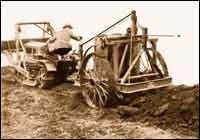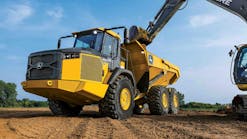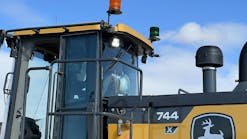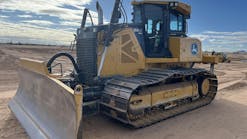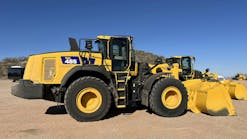The Miami Trailer-Scraper Co. offered scrapers that were rear dumping. Hoisting was performed either through the drive wheels or, with a special attachment for the tractor, by means of powered winch.
The earliest scrapers were little more than drag pans pulled by horses or even men. But when a contractor put two wheels on the pan in 1877, the two-wheel scraper came into being. The advantage was that the scraper could now lift its load, making it possible to carry a greater payload and carry the load easier. These machines began to proliferate, and soon hundreds of two-wheel scrapers might be seen on the same jobsite, requiring hundreds of horses and teamsters.
The Smith & Sons Mfg. Co. of Kansas City, Mo., added a platform to the scraper so that the operator could now stand. This was called the Royal Riding Wheeled Scraper. In the early 1880s, a popular scraper used in California was called the "buck" scraper. It consisted of a board standing on edge through its length. James Porteous improved on the buck scraper, adding a board that extended to the rear where the driver stood. It also featured an adjustable scraper board that could be laid back at an angle close to horizontal that enabled the scraper to haul some of its load.
In the early 1920s, a new type of scraper was introduced. Known as a rotary or roll-over scraper, it became better known as the "tumblebug" scraper. Designed to be towed by a tractor, one person could operate both the tractor and the scraper, providing a cost savings over horse-drawn scrapers. To dump the scraper, the tractor operator pulled a lever that allows the bowl to rotate to an upside down position. Offered by many manufacturers of the time, these scrapers were available in sizes up to 90 cubic feet.
By the mid-1920s, the Miami Trailer-Scraper Co. and Euclid Road Machinery offered scrapers that were rear dumping. Hoisting was performed either through the drive wheels or, with a special attachment for the tractor, by means of a powered winch. Scrapers were designed to be hooked into "trains" of two to five units. The Highway Trailer Co. came up with the first elevating scraper, designed with a "ladder" of scraper bars for pulling the dirt into the bowl.
In the late 1920s, McMillan Bros., an earthmoving contractor, developed a scraper that resembled the rotary scraper, but used hydraulic cylinders to lift the load off the ground. The bowl was pivoted between the trailing rear axle and the tongue. By 1930, the American Tractor Equipment Co. (ATECO) of Oakland, Calif. developed the McMillan patents and sold the scraper under the ATECO name. By 1933, Blaw-Knox was marketing the ATECO. In 1940, Huber Manufacturing offered the "speed scoop," a hydraulically operated machine similar to the rotary scraper.
Continental Roll & Steel Foundry of Chicago introduced a pneumatic-tire version of the two-wheel scraper. Other companies in the 1930s and 1940s came up with their own version of the machine. Over the years, two-wheel scrapers were used as an agricultural tool and, recently, two-wheel scrapers are becoming popular again in construction.
Information taken from "Evolution of the Two-Wheel Scraper" by Don Frantz in the Spring 2003 issue of Equipment Echoes, published by the Historical Construction Equipment Association. For more on HCEA, including membership information, visit www.hcea.net.
